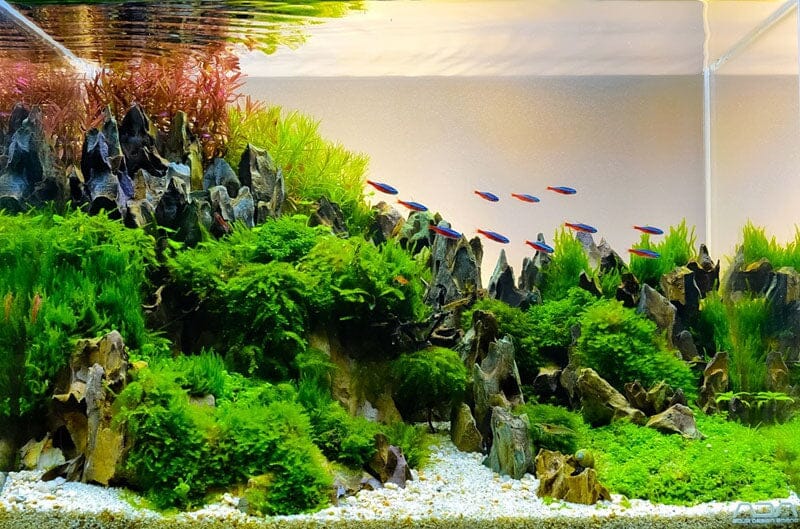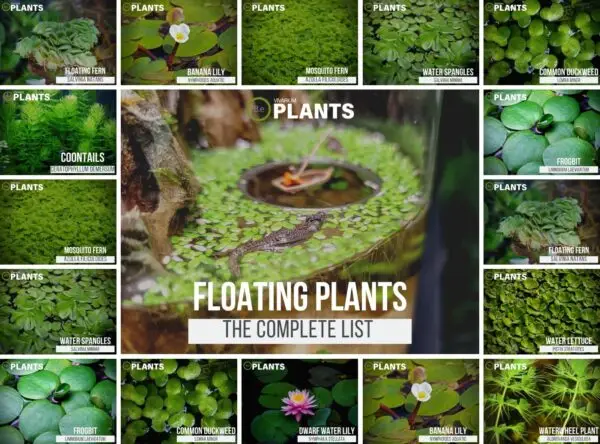Floating aquarium plants add beauty and health benefits to your tank. They help create a natural environment for fish and other aquatic life.
Choosing the best floating plants can transform your aquarium into a lush, thriving ecosystem. These plants not only enhance the visual appeal of your tank but also offer practical benefits. They provide shade, reduce algae growth, and help maintain water quality.
Whether you’re a beginner or a seasoned aquarist, selecting the right floating plants is crucial. This guide will introduce you to some of the best options available. Discover how these plants can improve your aquarium’s overall health and beauty. Your underwater world will thank you!
Introduction To Floating Aquarium Plants
Floating aquarium plants offer a unique charm and functionality to aquariums. These plants drift on the water’s surface, creating a natural look. They provide shade, reduce algae growth, and offer hiding spots for fish.
Benefits Of Floating Plants
Floating plants help maintain water quality. They absorb harmful nutrients and produce oxygen. This keeps the tank environment healthy. These plants also reduce stress for fish. They give a sense of security by offering cover and shade.
Floating plants are easy to care for. They do not need complex setups or special substrates. Just let them float, and they will thrive. They also add a beautiful green touch to your aquarium.
Types Of Aquariums For Floating Plants
Different aquariums suit floating plants well. Freshwater tanks are perfect for these plants. They can also work in brackish water tanks. Most floating plants do not fare well in saltwater tanks.
Aquariums with gentle water flow are ideal. Strong currents can push the plants around too much. Tanks with good lighting support plant growth. LED lights are often the best choice.
Top Floating Aquarium Plants
Floating aquarium plants can add beauty to your tank. They also offer many benefits, like improving water quality and providing shelter. These plants float on the water’s surface, creating a natural look. In this section, we will explore some top floating aquarium plants.
Amazon Frogbit
Amazon Frogbit is a popular choice for many aquarists. It has large, round leaves that float on the water. This plant grows fast and provides shade for fish. It also helps in reducing algae growth. Its long roots offer a hiding place for small fish and shrimp. Amazon Frogbit is easy to care for and thrives in most tanks.
Water Lettuce
Water Lettuce is another excellent floating plant. It has rosette-shaped leaves that resemble small lettuce heads. This plant floats on the surface and can spread quickly. Water Lettuce provides excellent cover for fish and helps maintain water quality. Its roots hang down, creating a natural look in your tank. This plant is ideal for larger aquariums due to its size and growth rate.
Choosing The Right Floating Plants
Choosing the right floating plants for your aquarium can enhance its beauty and health. Floating plants offer many benefits like providing shade, reducing algae growth, and offering hiding spots for fish. But, not all floating plants are the same. Understanding their size, growth rate, light, and nutrient needs will help you make the best choice for your tank.
Size And Growth Rate
Floating plants come in various sizes and have different growth rates. Knowing this helps in selecting the best plants for your aquarium size. Some plants grow very fast and can cover the water surface quickly. Others grow slowly, which might be better for smaller tanks.
- Small Tanks: Choose plants like Duckweed or Frogbit. These plants stay compact and do not overgrow.
- Large Tanks: Opt for larger plants like Water Hyacinth or Amazon Frogbit. They can handle more space and grow faster.
Light And Nutrient Needs
Different floating plants have different light and nutrient requirements. Knowing these needs ensures the plants thrive in your aquarium.
| Plant | Light Needs | Nutrient Needs |
|---|---|---|
| Duckweed | Low to Medium | Low |
| Amazon Frogbit | Medium to High | Medium |
| Water Lettuce | High | High |
For tanks with low light, Duckweed is an ideal choice. It thrives in low-light conditions and requires minimal nutrients. If you have a well-lit tank, plants like Amazon Frogbit and Water Lettuce are better options. They need more light and nutrients to grow well.

Credit: www.aquaticexperts.com
Plant Care And Maintenance
Floating aquarium plants add beauty and health benefits to your tank. Proper care and maintenance are crucial to keep them thriving. Regular attention to trimming, cleaning, and disease prevention can ensure your plants remain healthy and vibrant.
Trimming And Pruning
Floating plants can grow quickly. Regular trimming and pruning help maintain their shape and size. Use clean, sharp scissors to cut away dead or overgrown parts. This will encourage new growth and prevent the plants from overcrowding your tank.
Trim the roots if they become too long. Long roots can interfere with the tank’s water flow. They can also trap debris, affecting water quality. Pruning also helps improve light penetration, which is essential for plant health.
Cleaning And Disease Prevention
Regular cleaning is vital for floating aquarium plants. Remove any debris or dead leaves from the water surface. This prevents decay and reduces the risk of disease. Clean the tank walls and equipment to prevent algae buildup.
Inspect your plants for signs of disease. Look for discolored leaves, unusual spots, or stunted growth. These can indicate a problem. Remove any affected parts immediately to prevent the spread of disease.
Use a gentle water flow to avoid damaging the plants. Ensure the water parameters, such as pH and temperature, are within the ideal range for your specific plant species. This helps in keeping your plants healthy and disease-free.
Consider using natural remedies, like adding beneficial bacteria, to maintain a healthy environment. Avoid harsh chemicals, as they can harm both plants and fish.
Compatibility With Fish And Other Plants
Choosing the best floating aquarium plants is more than just about aesthetics. These plants must also be compatible with the fish and other plants in your tank. This ensures a healthy and balanced ecosystem. Some fish species benefit more from floating plants. Additionally, combining these plants with other species can create a thriving underwater world.
Fish Species That Benefit
Certain fish species thrive with the presence of floating plants. These plants offer shelter, breeding grounds, and even food sources for some fish. Here are a few fish species that benefit from having floating plants:
- Betta Fish: Betta fish love to hide under floating plants. The plants provide a sense of security and reduce stress.
- Guppies: Guppies often use the plants as a place to give birth. The dense cover helps protect the fry from predators.
- Goldfish: Goldfish enjoy nibbling on the roots of floating plants. This can be a good supplement to their diet.
- Angelfish: Angelfish use the plants for laying eggs. The plants offer a safe and secure location for breeding.
Combining With Other Plants
Floating plants can coexist with many other types of plants in your aquarium. They add a unique layer to your tank and can enhance the overall health of the ecosystem. Here are some tips for combining floating plants with other plants:
| Plant Type | Compatibility | Benefits |
|---|---|---|
| Submerged Plants | High | Provide oxygen and shelter for fish |
| Rooted Plants | Medium | Stabilize substrate and reduce algae |
| Carpet Plants | Low | Cover the tank bottom and offer hiding spots |
When combining floating plants with other plants, consider the light requirements. Floating plants can block light from reaching submerged or rooted plants. Choose floating plants with sparse foliage if your tank includes light-sensitive plants. Also, ensure the floating plants do not cover more than 50% of the tank’s surface. This balance will keep all your plants and fish healthy.
Creating A Balanced Aquascape
Creating a balanced aquascape is key to a thriving aquarium. Floating plants play a significant role in achieving this balance. They provide shade, reduce algae growth, and offer a natural habitat for fish. This section will guide you on how to use floating plants effectively to create a harmonious aquascape.
Design Tips
Begin by selecting the right floating plants for your aquarium. Popular choices include Duckweed, Water Lettuce, and Frogbit. These plants are easy to maintain and adapt well to different water conditions. Arrange them in clusters to create a natural look. Use a mix of plant sizes to add depth and dimension to your aquascape.
Consider the growth rate of each plant. Fast-growing plants may need regular trimming to prevent overcrowding. On the other hand, slow-growing plants can help maintain a stable environment. Balance is crucial. Too many plants can block light, while too few may not provide enough cover for fish.
Balancing Light And Shade
Floating plants can create pockets of light and shade in your aquarium. This balance is essential for the well-being of your fish and other aquatic life. Place floating plants in areas where they can diffuse light effectively. This helps prevent algae overgrowth and keeps the water cool.
Monitor the light intensity in your tank. Ensure that all areas receive adequate light. Floating plants should not block too much light from reaching the plants below. Adjust plant placement as needed to maintain a healthy light balance. Use a combination of floating and rooted plants to create a dynamic and visually appealing aquascape.
Common Problems And Solutions
Floating aquarium plants add beauty and balance to your tank. Yet, they can face issues that affect their health and appearance. Common problems include algae growth and nutrient deficiency. Understanding these problems and knowing their solutions can help maintain a healthy aquarium.
Algae Growth
Algae growth is a common issue in aquariums with floating plants. Excess light and nutrients often cause this problem. Algae can cover plant leaves, blocking light and harming plant health.
Solutions:
- Reduce the light exposure to your aquarium. Keep it between 8-10 hours daily.
- Use algae eaters like snails or fish to control algae growth.
- Perform regular water changes. This helps remove excess nutrients.
- Consider using a UV sterilizer to kill algae spores in the water.
Nutrient Deficiency
Nutrient deficiency can also affect floating plants. They need essential nutrients to grow and stay green. Symptoms include yellowing leaves and stunted growth.
Solutions:
- Use a balanced liquid fertilizer. Choose one that provides micro and macro nutrients.
- Ensure proper water circulation. This helps distribute nutrients evenly.
- Test the water regularly. Check for nutrient levels and adjust as needed.
- Add some root tabs if the plants are rooted in the substrate.
:strip_icc()/GettyImages-1297468554-e4f46657f17e4c71b3d5b7eac3564f32.jpg)
Credit: www.thesprucepets.com
:strip_icc()/GettyImages-1270555572-1afcc69ffd234775a0e63aadcd9e20a7.jpg)
Credit: www.thesprucepets.com
Frequently Asked Questions
What Are Floating Aquarium Plants?
Floating aquarium plants are plants that float on the water’s surface. They don’t need soil. They provide shade and shelter for fish. They also help in maintaining water quality.
Which Floating Plants Are Best For Beginners?
Duckweed, Frogbit, and Water Lettuce are great for beginners. They are easy to care for. These plants grow quickly and require minimal maintenance.
Do Floating Plants Need Special Lighting?
Most floating plants need moderate to high lighting. Good lighting helps them grow healthily. Ensure your aquarium light is suitable for plant growth.
Can Floating Plants Improve Water Quality?
Yes, floating plants can improve water quality. They absorb excess nutrients and reduce algae growth. They also provide oxygen to the water.
Conclusion
Floating aquarium plants add beauty and balance to your tank. They provide hiding spots for fish and help maintain water quality. Choose plants that fit your tank’s needs. Common options include duckweed, frogbit, and water lettuce. Each plant offers unique benefits and looks.
Adding floating plants can create a healthier, more vibrant aquarium. So, explore and find the best plants for your setup. Your fish will thank you for it. Enjoy the natural beauty of a well-planted tank!





